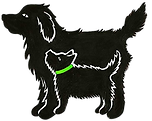The Amazing World of Touch & What Touch Means to a Dog
- plawrenceteulon
- Nov 9, 2020
- 3 min read


Communicating Without Speech
As dog lovers, we all know how much dogs love to be stroked, or to have a cuddle with us on the sofa, but touch for dogs is much more important than just to be comforted or feel secure.

Communicating Through Touch
You will have noticed your dog touches you in different ways depending on how they are feeling, when they are scared they may press into your leg for protection, or paw you to try to get you to play. We experience the second one a lot at Oakington Dog Day Care Centre, the dogs always love to get us to play with them!
Dogs are very clever and will always try to express how they are feeling, not always very subtly!

How Dogs Learn About the World


Dogs experience the world differently to us, and although they cannot speak, they communicate with us and other dogs very effectively using body language and touch. When a puppy is born, they have no sight or hearing, so they rely on touch and smell to guide them to their mother for milk, to seek out their sibling’s warmth, and to explore their environment. Puppies learn to communicate through touch; nipping, licking and pawing are all common ways a puppy learns how to interact with their environment and others in it. Allowing a puppy to bond with its mother, siblings and humans from an early age enhances the puppy’s abilities to develop new social bonds in the future.

Touch is also important in adult dogs; each hair on a dog’s body has a receptor at its base in the skin. This complex network of receptors in the skin allows dogs to sense pain, body movement and position, changes in temperature and chemical stimulation, as well as touch and pressure. The most sensitive receptors are at the base of the whiskers and dogs use these for spacial awareness, balance and to feel the environment around them.
Tactile Surfaces for your Dog to Enjoy at Day Care
At Oakington Dog Day Care, we are always thinking about how our body language and touch affects the dogs in our care. We like to keep a calm environment whilst also allowing the dogs to play and have fun. Dogs often come to us for a cuddle, and we are more than happy to oblige! Gentle, calm strokes can help to lower the heart rate and calm an excitable or fearful dog and we love using gentle strokes to help the dogs that are resting fall asleep. It’s also great seeing a nervous dog become more confident when we use playful and open body language to bring them out of their shell.

There are plenty of things to explore at day care, all with a variety of smells and textures to experience. We have a wooded area, short and long grasses in our field with a variety of dog friendly plants for them to sniff, a wild garden filled with a range of wild grasses and mints that grow around our seasonal pond, and a sensory garden to help stimulate them mentally.

Our sensory garden is in a lovely shady spot under a large tree, we have dirt and grass for them to experience under their toes, as well as variety of extra tactile floor surfaces we have provided them. We have used rubber matting, both the smooth and rough sides, on top of our climbing equipment for grip, upcycled foam mats for paths around our sensory garden, and even use tyres and pools to allow the dogs to experience a variety of textures. Transitioning between the dirt, grass, rough and smooth surfaces of the ground and flooring around the centre keeps the dogs mentally stimulated and allows them to experience new things.
We love seeing how focused the dogs are with all the different tactile sensations they are experiencing, and it is great fun seeing puppies conquer their fears of a scary rubber mat and becoming comfortable enough to climb and play on it.
We always post photos on our social media pages of the dogs experiencing new things and enjoying our facilities, we hope you enjoy their happy faces as much as we do!



















































